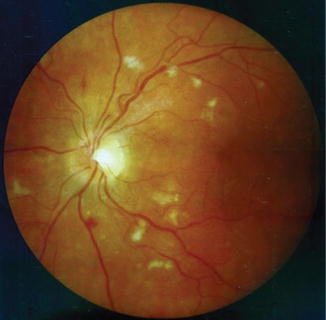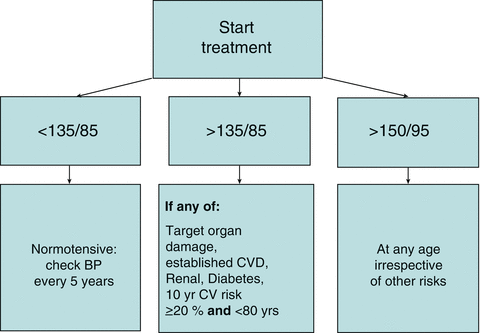and Christopher Isles2
(1)
Institute of Cardiovascular and Medical Sciences, University of Glasgow, Glasgow, UK
(2)
Dumfries and Galloway Royal Infirmary, Dumfries, UK
This chapter is primarily concerned with the diagnosis, investigation and management of hypertension generally, though many of the questions and answers are relevant to patients with CKD too.
Q1 What do you understand by the terms systolic and diastolic blood pressure?
Blood pressure is the term used to describe the pressure that exists within the main arteries. This is written as systolic/diastolic e.g. 120/80 mmHg. Systolic blood pressure is best thought of as the pressure in the main arteries with each heart contraction, and diastolic pressure the pressure in the main arteries when the heart is relaxing.
Q2 Define hypertension.
Hypertension is that level of blood pressure at which the benefits of treatment outweigh the risks. In those with kidney disease, heart disease, previous stroke or diabetes, the level at which benefits outweigh risks of treatment and is thought to be around 140/90 mmHg. For younger patients at low risk who have nothing else wrong e.g. a young woman who does not smoke, have high cholesterol or a family history of premature vascular disease it may be acceptable to monitor BP in the range 140/90–160/100 without drug treatment (see later).
Q3 What is meant by the term isolated systolic hypertension?
Isolated systolic hypertension means a systolic pressure >140 mmHg and a diastolic pressure <90 mmHg. This is a common finding in older patients, including those on dialysis, and is likely to reflect the fact that they have stiffer arteries than younger people.
Q4 Discuss how you might use clinic BP, home blood pressure monitoring (HBPM) & ambulatory blood pressure monitoring (ABPM) to make a diagnosis of hypertension.
The NICE 2011 guideline on hypertension recommends greater use of ambulatory and home monitoring to confirm the diagnosis of hypertension. ABPM is still probably the gold standard but HBPM is a suitable alternative and certainly more convenient for the patient (Fig. 24.1).


Fig. 24.1
NICE guideline recommendation for confirmation of hypertension
Q5 What risks are associated with hypertension?
Hypertension increases the risk of heart attack and stroke by a factor of 2–4. Hypertensive patients are more likely to present with heart failure and to have peripheral vascular disease including abdominal aortic aneurysms. Patients whose diastolic pressure is greater than 130 mmHg may develop a condition called malignant hypertension, particularly if the rate of rise of their blood pressure is very rapid. Malignant hypertension is characterised by headaches and visual blurring, is associated with retinal haemorrhages, exudates and papilloedema, and can also cause renal failure. In countries such as South Africa malignant hypertension is the commonest cause of kidney disease requiring dialysis (Fig. 24.2).


Fig. 24.2
Hypertensive retinopathy as seen on fundoscopy showing flame haemorrhages, “cotton wool” spots and papilloedema
Q6 What lifestyle measures have been shown to lower blood pressure?
The lifestyles measures that have been shown to reduce blood pressure include weight reduction if obese, salt restriction to a pinch of salt in cooking with none at table, and restriction of alcohol intake to less than 2 or 3 units per day. An overweight, heavy drinking hypertensive patient who adds small handfuls of salt to his food might expect to drop his systolic blood pressure by 5–10 mmHg by losing weight and restricting both his salt and alcohol intake. Kidney patients should be advised not to buy Lo-Salt in the belief that this will be better for them than ordinary salt. Lo-Salt contains potassium chloride, and while there is some evidence that this might lower blood pressure slightly, the risks of hyperkalaemia far outweigh the benefits. Stopping smoking will not lower blood pressure but will reduce risk of heart attack and stroke by other means. Patients whose blood pressure remains high despite lifestyle measures will require drug therapy.
Q7 What level of blood pressure would you recommend antihypertensive drug treatment?
The NICE 2011 guideline recommends starting antihypertensive drug treatment immediately if clinic BP ≥180/110 mmHg. If clinic BP is less than this then NICE suggest that the decision on drug treatment should be based on the results of ABPM/HBPM, the patients age and the presence or absence of target organ damage and other risk factors as shown below (Fig. 24.3):
 < div class='tao-gold-member'>
< div class='tao-gold-member'>





Only gold members can continue reading. Log In or Register to continue
Stay updated, free articles. Join our Telegram channel

Full access? Get Clinical Tree








